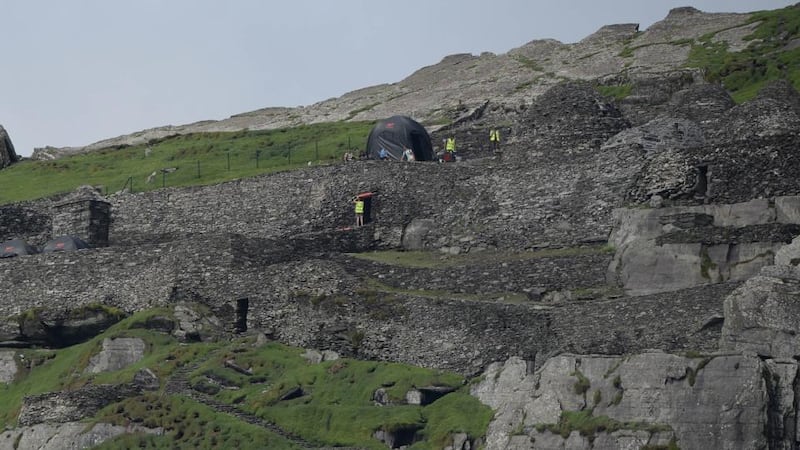Independent film and video company Bold Puppy stole a neat march on director JJ Abrams this week, with its YouTube take on X-Wing fighter flypasts off the Co Kerry coastline.
“Visit Star Wars newest universe! Portmagee, Co Kerry, Ireland” proclaims the one-and-a-half minute video, complete with cameo shots of C-3PO and Chewbacca, and AT-AT fighters stalking through the Skellig Michael monastery to that familiar John Williams musical score.
“It took us about three hours,”say the Bold Puppy team, a group of very creative but very homesick Kerry people based up in the capital, who are safely able to say that no archaeology or wildlife was harmed in the making of their virtual reality film.

About 35 years ago, a remote Norwegian mountain village of Finse had a taste of the international attention focused on Portmagee and Valentia island this week when George Lucas’s team chose it as a location for Star Wars V: the Empire Strikes Back.
Situated close to the Hardanger Jokulen glacier, it was training ground for the unsuccessful Scott expedition to the South Pole, it can only be reached by rail and is the highest station on the Norwegian railway system.
Since it was transformed into ice planet Hoth for Princess Leia and her crew, its winter sports tourism business has been boosted by visitors who like to imagine Skywalker’s encounter with the spectre of Obi-Wan Kenobi, and come armed with tourist guide longitude and latitude information on where various scenes were filmed.
Exploding asteroids and laser light beams and heroes hiding in monastic beehive huts will look similarly spectacular on Skellig Michael — even it only appears for a few minutes. And though the plot of the new Disney/Lucasfilm blockbuster is a “tight secret”, Mark Hamill’s sporting of a “contractually-obligated beard”, as he put it, on BBC television last week has fuelled speculation that the original Luke Skywalker has based a Jedi academy on the 400-million-year-old sandstone rock.
It takes a brave voice — or three — then to question authorisation for activity which is said to have Portmagee "buzzing", which has the Naval Service patrol ship LE Samuel Beckett policing a two-mile exclusion zone at sea, and which will ensure that Skellig Michael becomes another "cinema classic" location, like the Dingle peninsula (Ryan's Daughter ) and Mayo's Cong (The Quiet Man). The difference is that one of the most fragile and significant early medieval archaeological sites in Western Europe, holding UNESCO world heritage status, doesn't need mass tourism – the opposite, in fact. Hence, strictly controlled visitor access by the Office of Public Works (OPW) over many years.
Not everyone has been happy with the OPW’s approach, including ferrymen - who are now reportedly very content with both work and compensation. Archaeologist Michael Gibbons has criticised the over-embellished approach of some of the restoration, and damage sustained during this work on several key features. His concerns prompted a UNESCO report in 2007 which found that conservation on the South Peak had “dramatically” transformed the appearance of monastic remains. The report did state that the work was “justifiable”, and it retained its “outstanding universal values” but advised that conservation work should be documented and management be tightened up.
Permission for a blockbuster film onsite seems a relatively minor intrusion in comparison, Gibbons remarks, but he believes it illustrates “how behind and out of touch the State’s heritage authorities are with world heritage best practices”. The project “would not have been tolerated by the Scottish authorities on Iona, the French authorities on Mont Saint-Michel, or on St Michael’s Mount in Cornwall”, he says, and archaeology colleague Dr Niamh Whitfield, who is an expert in early medieval Irish art, says she is “astonished” that permission has been given.
The Irish Film Board had said that the programme has all necessary authorisations, including National Parks and Wildlife Service (NPWS) approval and “has been designed specifically to avoid disturbance of breeding birds on the island”. However Birdwatch Ireland’s senior conservation officer for seabirds Steven Newton has no confidence in that assurance, given that it is the middle of a busy nesting season for thousands of pairs of puffins, Manx Shearwaters and the tiny Stormy Petrels.
Newton estimates that there are up to 10,000 breeding pairs of Stormy petrels – which can fly 6,000 miles – in and around crevices in the monastery walls and beehive huts, and in underground burrows. Press photographs this week show tents and portaloos on the saddle between the two peaks. Who knows how many nests underneath hold now abandoned eggs or chicks.
Newton has made it clear he has no problem with filming in the autumn when the birds have flown - and September was originally mooted, until Harrison Ford, alias Hans Solo, broke his leg, and schedules were changed. In spite of a number of requests by this newspaper, neither the Department of Arts, Heritage and the Gaeltacht, which is responsible for policy on Skellig Michael and for the NPWS, nor the OPW, Skellig Michael’s principal manager, have been able to furnish any details of independent consultancy reports or conditions attached.
We have no idea if or how much Disney/Lucasfilms paid to use the State location, and if former arts minister and Kerry TD Jimmy Deenihan had a role. Skellig Michael advisory committee, albeit restricted to overseeing research and publication work, wasn’t consulted at all.
What’s worse, press queries to both departments are being referred to the Irish Film Board – even Darth Sidious would spot the conflict of interest in that. Both the NPWS and the Irish Film Board come under the remit of Minister for Arts, Heritage and the Gaeltacht Heather Humphreys. Perhaps next time she could suggest that Bold Puppy gets the gig.










